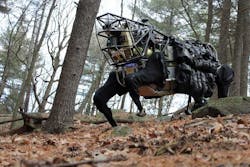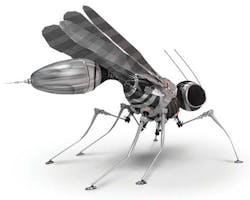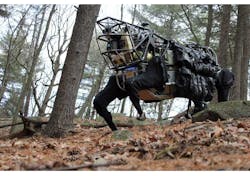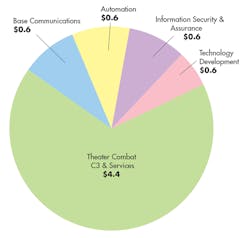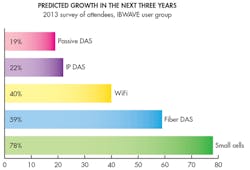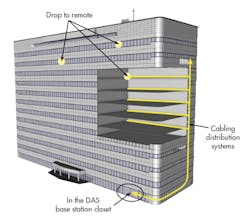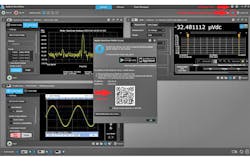This file type includes high resolution graphics and schematics when applicable.
This next year will see the advancement of a revolution in connectivity between man and data. The depth and design of this connectivity will bring us closer to technology and our bodies while enhancing our ability to compete electronically on the battlefield. The development of RF technologies, which are of course key to connected systems, is making possible technologies that were once relegated to pure fantasy (Fig. 1).
Among the highlights of upcoming technological developments are machines with greater mobility and intelligence; low-cost, military-grade multi-function devices; wireless data access virtually everywhere; and the ability to rapidly and accurately test the latest technologies.
Unmanned Systems
From intelligent flying drones that mimic insects or birds of prey to pack-mules for land-based troops, the Department of Defense (DoD) is heavily invested in developing incredibly capable unmanned systems for land, air, and sea (Fig. 2). In doing so, it is partnering with other agencies, such as the Defense Advanced Research Projects Agency (DARPA) and the Office of Naval Research (ONR).
The resulting systems rely on RF technologies for communications, control, and the ability to “see” the world around them. Such heightened intelligence, in turn, leads to a demand for greater sensing and communications capabilities for reporting, threat identification, and coordination.
Looking at the current state-of-the-art in drones, last year saw the testing of pack-mule drones, the legged squad support system (LS3) by DARPA, and the development of add-on autonomy kits. Those autonomy kits, which hail from ONR and Lockheed Martin, can turn a variety of military vehicles (like a ground support vehicle or V-22 Osprey) into semi-autonomous robots.
Much of the investment in drone technology has focused on devices that eliminate the need for human soldiers to participate in support roles, such as ferrying supplies and cargo across the battlespace. In addition to fatiguing and stressing soldiers, such tasks often result in casualties. Thus, the use of autonomy kits and drones can help militaries save lives. At the same time, they can reduce spending and focus on force-multiplying and performance-enhancing technologies.
In a similar vein, much of the US military’s drone system development seeks to enable troops to virtually extend their reach into a battlefield using remotely controlled robots. Such robots can operate semi-autonomously or via direct human control. Here, much also is saved in terms of training costs.
For example, a sergeant who is already familiar with video-game controls can learn to remotely pilot the latest combat equipment with much less time and effort—especially when compared to the level of education and training needed to ready a physicist/engineer/pilot to operate the latest combat craft. Recognizing this trend, the Navy has funded the development of an autonomous and controllable fighter aircraft. The use of machine swarms also is being considered and tested to combat high-number and enemy swarm threats–particularly in naval environments.
Of course, the communications links and coordination electronics for these systems rely completely on wireless technologies. These wireless developments require more intelligent and integrated RF/microwave/millimeter-wave technologies, which can be rapidly reconfigured and reprogrammed. Over time, technologies that integrate high-performing computation hardware, RF hardware, and a sophisticated, flexible software plane will increasingly be employed. Those integrated technologies also will advance over time, thus better enabling these autonomous and remotely controlled machines to function on a battlefield that is brewing with complexity and threats.
Among the technologies that will be enhanced to provide the adaptability and control needed by these systems are software-defined radios, field-programmable gate arrays (FPGAs), GaN on silicon, and reconfigurable RF devices. Due to the high numbers of these systems, modular and mass-manufacturing techniques also will be critical in enabling the next generation of defense robots.
Commercial-Off-the-Shelf Components
To cope with the need for cost-effective military systems that can still compete with the latest threats, both the military-technology supply chain and design approach must be reinvented (Fig. 3). Part of this trend revolves around using high-performing and rugged commercial-off-the-shelf (COTS) components in modern military equipment and modular design. The old method of low-volume, highly custom components is now largely outdated, thanks to modern DoD requirements. Today’s defense contractors/sub-contractors are designing and using components and subsystems that can meet the needs of both high-volume commercial/industrial applications and the stringent demands of the modern battlefield.
Specifically, size, weight, power, and cost (SWAP-C) is driving the use and development of COTS devices and modular-open-systems-architecture (MOSA) approaches. These design criteria are hypercritical for electronic-warfare (EW) and radar systems, as they will be employed with unmanned vehicles in the land, air, and sea. These EW; radar; and intelligence, surveillance, and reconnaissance (ISR) systems also are supposed to undergo more technical blending, as the hardware and software controlling them increasingly adopts the same technologies.
At the core of all of these devices, for example, are an SDR, FPGAs, digital-signal-processing (DSP) units, general-purpose processors (GPPs), and very-high-speed domain-conversion technologies. As GaN is incorporated onto substrates like silicon, further integration will be seen in digital systems.
In the near future, these devices will actually occupy the same module, if not the same integrated circuit (IC). Such high levels of integration are already being seen in next-generation EW technologies, such as Raytheon’s next-generation jammer (NGJ). This active electronically steered array (AESA) jammer is both an extremely powerful radar and a remotely networked SDR.
GaN will continue to provide greater power density while solving thermal control challenges. In the more distant future, carbon-based electronics will take GaN’s place to provide even higher density. As a result of these advancements, RF devices will merge closer to the analog and digital devices in the modular card or box-based systems built on open architectures. Examples include PXI/PCI, AXI, and VME card-slot-based modular hardware with an abstracted software layer.
By taking a proprietary approach—as Mercury Systems is doing with its OpenRFM architecture—or leveraging the Advanced Telecom Computing Architecture (ATCA), companies are working to modularize RF systems in combat aircraft. Their goal is to create an open standard based on easily replaceable modules, which can support a variety of different configurations and functions. Such systems are built on a common hardware interface. Software abstractions dictate whether device behavior will be modified via a rapid module swap in the field or simple reprogramming.
This type of design approach offers great benefits for the defense industry, as it lowers the time spent on design, deployment, modernization, and maintenance. It also cuts the cost factors associated with future-proofing and upkeep. In the commercial and industrial computer-electronics industry, COTS and MOSA-focused designs comprising common hardware with software abstraction have already been embraced. They have proven to be a cost-effective and rapid method of fielding high-performance products, which may further entice military interests.
This file type includes high resolution graphics and schematics when applicable.
Small Cells and Distributed Antenna Systems
This file type includes high resolution graphics and schematics when applicable.
Outside of the military arena, the largest worldwide trend that continues to escalate is the growth of mobile data traffic . Currently, Cisco is predicting monthly mobile data traffic of greater than 15 exabytes by 2018, while urbanization is leading to more tightly packed in-building and urban environments. As a result, miniaturization of the cellular structure and high-speed mobile data connections in every nook and cranny is a must (Fig. 4). Video streaming and personal data services are a big driver.
In addition, public-safety demands for location and security information is requiring greater connectivity throughout urban environments. Substantial cellular offloading onto Wi-Fi networks also is occurring. Meanwhile, the demand for seamless high-speed mobile data is encouraging solutions that are cost effective to install and maintain.
This burden will ultimately fall on small cells and DASs that are built into (or onto) buildings and urban centers, such as stadiums (Fig. 5). Traditionally, small cells have operated as miniaturized macrocells, with higher capacity, lower cost per area, and operational expenditure (OPEX) benefits over DAS. DAS traditionally benefits from neutral host and macrocell parity.
Recently, DASs also have begun to integrate typical small-cell features, such as traffic steering and accessibility to a wide range of wireless networks and backhaul. As the winning features of DASs and small cells begin to blend, their benefits are likely to converge using the same highly integrated and flexible hardware.
These hybrid networks or distributed radio systems (DRSs) will likely use centralized baseband functionality in combination with a cloud radio access network (CRAN) for the distribution of a common public radio interface (CPRI). Fiber networks will most likely carry the radio functions to remote radio heads (RRHs) throughout a building.
In addition, lower-cost common cabling, such as catV or other Ethernet lines with built-in power distribution, will be used to lower costs and complexity. Ericsson, SpiderCloud Wireless, and other companies are already building highly integrated and potentially cost-effective DAS units that use some of these concepts. It is likely that such features will continue to advance.
The Next Wave in Software and T&M
To keep up with the complexity and speed of the modern test environment, there has been significant movement away from large rack-mount and benchtop test and measurement instrumentation. This trend is not solely cost driven, as fewer experienced engineers will be available to oversee and perform complex testing of the latest devices. As a result, there is a need for more automation, diversity of features, and ease of set-up/control.
At the same time, moving the computer out of a test and measurement instrument and onto a centralized device has enabled a drastic reduction in the cost and size of common instruments, such as spectrum analyzers, network analyzers, and oscilloscopes. PXI- and AXI-based test systems continue to improve as application-specific-integrated-circuit (ASIC) techniques advance the performance of instrumentation in the footprint of ICs.
Additionally, the software abstraction and common hardware environments is extending the features of traditional instruments to include many multi-functional instruments. Currently, these compound instruments are relegated to low-end performance. As the adoption and demand for this approach rises, however, more features will be integrated into these modular instruments.
Eventually, this level of integration will be so high that software and branding will become the differentiating factor of an instrument (Fig. 6).
These trends could lead to different instrumentation manufacturers outsourcing to common hardware vendors. They will simply use operating-system platforms to compete in the development of apps and techniques, very similar to the smartphone industry. With PC-driven test instruments offering much lower prices for performance than was previously possible, cost competitiveness—even with higher-performing instruments—will also drive this development. This trend stems from smaller military budgets and the cost-centric purchasing of telecommunications companies.
This cost-driven planning, along with the increased integration of intelligent computer systems into test and measurement environments, is feeding the development of automated testing and more sophisticated software control and analysis. The automation of instrumentation is necessary to efficiently test the enormous numbers of mobile devices, such as smartphones, tablets, and Internet of Things (IoT) devices with complex modulation schemes. As the pace of technology development continues to quicken, configurability is also critical.
Looking into the future, another approach to handling hardware complexity and the merging of digital, analog, and RF domains is building automated testing into the devices themselves. An automated self-test approach could—and inevitably will—remove the need for many of repetitive, simple tests on higher-cost devices. Yet external, higher-performing test equipment will still be needed to measure very-low-cost devices and for characterization/validation/compliance.
This file type includes high resolution graphics and schematics when applicable.
About the Author
Jean-Jacques DeLisle
Jean-Jacques graduated from the Rochester Institute of Technology, where he completed his Master of Science in Electrical Engineering. In his studies, Jean-Jacques focused on Control Systems Design, Mixed-Signal IC Design, and RF Design. His research focus was in smart-sensor platform design for RF connector applications for the telecommunications industry. During his research, Jean-Jacques developed a passion for the field of RF/microwaves and expanded his knowledge by doing R&D for the telecommunications industry.
